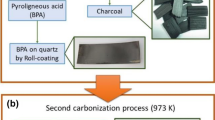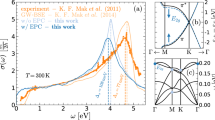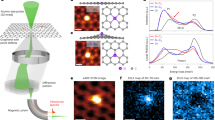Abstract
Infrared absorption of atomic and molecular vibrations in solids can be affected by electronic contributions through non-adiabatic interactions, such as the Fano effect. Typically, the infrared-absorption lineshapes are modified, or infrared-forbidden modes are detectable as a modulation of the electronic absorption. In contrast to such known phenomena, we report here the observation of a giant-infrared-absorption band in reduced graphene oxide, arising from the coupling of electronic states to the asymmetric stretch mode of a yet-unreported structure, consisting of oxygen atoms aggregated at the edges of defects. Free electrons are induced by the displacement of the oxygen atoms, leading to a strong infrared absorption that is in phase with the phonon mode. This new phenomenon is only possible when all other oxygen-containing chemical species, including hydroxyl, carboxyl, epoxide and ketonic functional groups, are removed from the region adjacent to the edges, that is, clean graphene patches are present.
This is a preview of subscription content, access via your institution
Access options
Subscribe to this journal
Receive 12 print issues and online access
$259.00 per year
only $21.58 per issue
Buy this article
- Purchase on Springer Link
- Instant access to full article PDF
Prices may be subject to local taxes which are calculated during checkout





Similar content being viewed by others
References
Kharissova, O. V. & Kharisov, B. I. Graphenes, one of the hottest areas in the nanotechnology: attention of chemists is needed. Open Inorg. Chem. J. 2, 39–49 (2008).
Novoselov, K. S. et al. Electric field effect in atomically thin carbon films. Science 306, 666–669 (2004).
Wallace, P. R. The band theory of graphite. Phys. Rev. 71, 622–634 (1947).
Novoselov, K. S. et al. Two-dimensional gas of massless Dirac fermions in graphene. Nature 438, 197–200 (2005).
Berger, C. et al. Electronic confinement and coherence in patterned epitaxial graphene. Science 312, 1191–1196 (2006).
Morozov, S. V. et al. Giant intrinsic carrier mobilities in graphene and its bilayer. Phys. Rev. Lett. 100, 016602–016606 (2008).
Wu, J. et al. Organic solar cells with solution-processed graphene transparent electrodes. Appl. Phys. Lett. 92, 263302–263304 (2008).
Geim, A. K. & Novoselov, K. S. The rise of graphene. Nature Mater. 6, 183–191 (2007).
Khveshchenko, D. V. Coulomb-interacting Dirac fermions in disordered graphene. Phys. Rev. B 74, 161402–161406 (2006).
Morozov, S. V. Strong suppression of weak localization in graphene. Phys. Rev. Lett. 97, 016801–016804 (2006).
Pisana, S. et al. Breakdown of the adiabatic Born–Oppenheimer approximation in graphene. Nature Mater. 6, 198–201 (2007).
Cai, W. et al. Synthesis and solid-state NMR structural characterization of 13C-labelled graphite oxide. Science 321, 1815–1817 (2008).
Park, S. et al. Graphene oxide papers modified by divalent ions enhancing mechanical properties via chemical crosslinking. ACS Nano 2, 572–578 (2008).
Eda, G., Mattevi, C., Yamaguchi, H., Kim, H. & Chhowalla, M. Insulator to semimetal transition in graphene oxide. J. Phys. Chem. C 113, 15768–15771 (2009).
Mattevi, C. et al. Evolution of electrical, chemical and structural properties of transparent and conducting chemically derived graphene thin films. Adv. Funct. Mater. 19, 2577–2583 (2009).
Ferrari, A. C. Raman spectroscopy of graphene and graphite: Disorder, electron–phonon coupling, doping and nonadiabatic effects. Solid State Commun. 143, 47–57 (2007).
Bruna, M. & Borini, S. Assessment of graphene quality by quantitative optical contrast analysis. J. Phys. D 42, 175307–175311 (2009).
Garcia-Sanchez, D. et al. Imaging mechanical vibrations in suspended graphene sheets. Nano Lett. 8, 1399–1403 (2008).
Lo, C. P., Quattrochi, D. A. & Luvall, J. C. Application of high-resolution thermal infrared remote sensing and GIS to assess the urban heat island effect. Int. J. Remote Sens. 18, 287–304 (1997).
Dresselhaus, M. S. Nanotube antennas. Nature 432, 959–960 (2004).
Parasido, J. A. & Starner, T. Energy scavenging for mobile and wireless electronics. IEEE Pervasive Comput. 4, 18–27 (2005).
Xia, F. et al. Ultrafast graphene photodetector. Nature Nanotech. 4, 839–843 (2009).
Goki, E., Giovanni, F. & Chhowalla, M. Large-area ultrathin films of reduced graphene oxide as a transparent and flexible electronic material. Nature Nanotech. 3, 270–274 (2008).
Lide, D. R. CRC Handbook of Chemistry and Physics 84th edn (CRC Press LLC, 2003).
Hartwig, C. M. & Rahn, L. A. Bound hydroxyl in vitreous silica. J. Chem. Phys. 67, 4260–4261 (1977).
Fukui, K., Miyauchi, H. & Iwasawa, Y. Highly sensitive detection of adsorbed species on a SiO2 surface by reflection absorption infrared spectroscopy. Chem. Phys. Lett. 274, 133–139 (1997).
Stankovich, S. et al. Synthesis of graphene-based nanosheets via chemical reduction of exfoliated graphite oxide. Carbon 45, 1558–1565 (2007).
Chabal, Y. J. Surface infrared spectroscopy. Surf. Sci. Rep. 8, 211–357 (1988).
Chabal, Y. J. Electronic damping of hydrogen vibration on the W(100) surface. Phys. Rev. Lett. 55, 845–848 (1985).
Zhang, Z. Y. & Langreth, D. C. Electronic damping of adsorbate fundamental and overtone vibrations at metal surfaces. Phys. Rev. B 39, 10028–10046 (1989).
Tang, T. et al. A tunable phonon–exciton Fano system in bilayer graphene. Nature Nanotech. 5, 32–36 (2010).
Gao, W., Alemany, L. B., Ci, L. & Ajayan, P. M. New insights into the structure and reduction of graphite oxide. Nature Chem. 1, 403–408 (2009).
Kosynkin, D. V. et al. Longitudinal unzipping of carbon nanotubes to form graphene nanoribbons. Nature 458, 872–876 (2009).
Hirata, M., Gotou, T., Horiuchi, S., Fujiwara, M. & Ohba, M. Thin-film particles of graphite oxide: High-yield synthesis and flexibility of the particles. Carbon 42, 2929–2937 (2004).
Mkhoyan, K. A. et al. Atomic and electronic structure of graphene oxide. Nano Lett. 9, 1058–1063 (2009).
Gilje, S., Han, S., Wang, M., Wang, K. L. & Kaner, R. B. A chemical route to graphene for device applications. Nano Lett. 7, 3394–3398 (2007).
Kresse, G. & Fürthmuller, J. Efficient iterative schemes for ab initio total-energy calculations using a plane-wave basis set. Phys. Rev. B 54, 11169–11186 (1996).
Kresse, G. & Joubert, D. From ultrasoft pseudopotentials to the projector augmented-wave method. Phys. Rev. B 59, 1758–1775 (1999).
Ceperley, D. M. & Alder, B. J. Ground state of the electron gas by a stochastic method. Phys. Rev. Lett. 45, 566–569 (1980).
Bader, R. Atoms in Molecules: A Quantum Theory (Oxford Univ. Press, 1990).
Huber, K. P. & Herzberg, G. Molecular Spectra and Molecular Structure, Constants of Diatomic Molecules Vol. 4 (Van Nostrand Reinhold, 1979).
Acknowledgements
The authors acknowledge the financial support of the SWAN-NRI program and Texas Instruments (TI), the technical expertise of J-F. Veyan and in-depth discussions with L. Colombo (TI) and with R. M. Wallace, E. Vogel, J. Kim, M. Kim, J-F. Veyan and W. Kirk at UT Dallas.
Author information
Authors and Affiliations
Contributions
M.A. carried out all infrared-spectroscopy work, including thermal-annealing experiments in parallel to chemical reduction. G.L. carried out all density functional theory and molecular dynamics simulations using theoretical methods. Y.J.C. and K.C. directed and supervised the experimental and theoretical research, respectively. M.A., G.L., K.C. and Y.J.C. contributed equally to the manuscript. C.M. prepared the single-layer and three-layer graphene oxide samples under M.C.’s supervision.
Corresponding author
Ethics declarations
Competing interests
The authors declare no competing financial interests.
Supplementary information
Supplementary Information
Supplementary Information (PDF 1092 kb)
Rights and permissions
About this article
Cite this article
Acik, M., Lee, G., Mattevi, C. et al. Unusual infrared-absorption mechanism in thermally reduced graphene oxide. Nature Mater 9, 840–845 (2010). https://doi.org/10.1038/nmat2858
Received:
Accepted:
Published:
Issue Date:
DOI: https://doi.org/10.1038/nmat2858
This article is cited by
-
Screening of new adsorbents to remove algal organic matter from aqueous solutions: kinetic analyses and reduction of disinfection by-products formation
Environmental Science and Pollution Research (2023)
-
Oxidative Molecular Layer Deposition Tailoring Eco-Mimetic Nanoarchitecture to Manipulate Electromagnetic Attenuation and Self-Powered Energy Conversion
Nano-Micro Letters (2023)
-
Graphene oxide synthesis using a top–down approach and discrete characterization techniques: a holistic review
Carbon Letters (2022)
-
Efficient method for synthesizing graphene materials applied in lithium-ion capacitors with high performance
Ionics (2022)
-
Acidity-dependent self-rolling of graphene oxide nanoscrolls via metal cation-π interaction
Science China Materials (2022)



